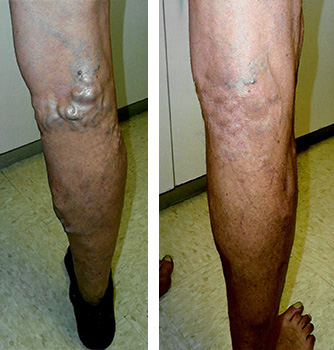Symptoms & Risk Factors
Symptoms of venous disease include:
- Swelling in your legs or ankles
- Pain in your legs or ankles, especially when you stand
- Heaviness or aching in your legs
- Itching legs
- Noticeable veins in your legs (beginning with spider veins)
- Thickening and/or darkening of the skin on your legs
You are at a greater risk for venous (vein) disease if you have these risk factors:
- Age 50+
- Previous blood clots
- Family history of vein disease
- Smoking
- Obesity
- Cancer
- Sedentary lifestyle (sitting for extended period of time)
- Varicose veins
- Pregnancy
Spider Veins
These are damaged veins most commonly seen on the legs or the face. Most people consider them unsightly and they can be painful.
Varicose Veins
Varicose veins are ones that have been weakened or damaged. They often appear as bulging or “rope like”, are generally unsightly and painful. Untreated varicose veins can cause serious complications, such as bleeding or clotting of blood.

Before & After
Lymphedema
Swelling in an arm or leg caused by a blockage in the lymphatic system. Although this is not always painful, some patients do experience pain with swelling.
Deep Vein Thrombosis (DVT)
Blood clots may form in a vein deep somewhere in your body, frequently in the leg. When this occurs, it’s referred to as “deep vein thrombosis.” The most common symptoms are new onset leg pain or swelling, may turn purple or red in color. If the clot breaks loose, it may move to your lung and block the blood flow. This is known as a pulmonary embolism.
Learn more about DVT
Venous Insufficiency
Some people have a vein problem created when the blood does not efficiently return from the legs back to the heart. When the blood collects in your legs they can become painful and swollen.
Venous Leg Ulcers
Serious problems with the leg veins can result in wounds on the legs that take a long time to heal due to poor blood circulation.
Pulmonary Embolism (PE)
When a clot breaks loose and travels to the lungs, it is called a pulmonary embolism; there it blocks the flow of the blood. PE is considered a medical emergency, so it should be addressed quickly. Some common symptoms of PE are shortness of breath, cough and pain while breathing and nausea and vomiting.
Learn more about Pulmonary Embolism (PE)
Peripheral Arterial Disease (PAD)
Peripheral Arterial Disease is a common circulatory problem in which narrowed arteries reduce blood flow to your limbs. Arteries supply blood to your legs and arms as well as many vital organs. Symptoms of PAD are weakness, numbness, heaviness and tiredness of legs and cramping in your calf (or calves). PAD is one of the leading causes of need for amputation. Risk factors include smoking, diabetes, high blood pressure, elevated cholesterol and family history. If you have any of these signs or symptoms and risk factors, it is important to inform your physician.
Learn more about PAD